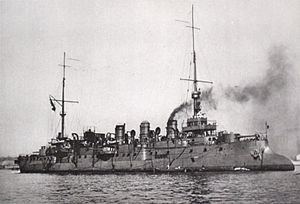Namesake Louis Pothuau Construction started 25 May 1893 Length 113 m | Preceded by Amiral Charner class Name Pothuau Ordered 11 April 1893 Launched 19 September 1895 Draft 6.4 m | |
 | ||
Builder Société Nouvelle des Forges et Chantiers de la Méditerranée | ||
The French cruiser Pothuau was an armoured cruiser built for the French Navy in the 1890s. She spent most of her active career in the Mediterranean before becoming a gunnery training ship in 1906. The ship participated in the Kamerun Campaign early in World War I before she was transferred to the Red Sea and Indian Ocean in 1916. Pothuau resumed her previous role after the war until she was decommissioned in 1926 and sold for scrap the following year.
Contents
Design and description
Pothuau measured 113.1 metres (371 ft 1 in) long overall with a beam of 15.3 metres (50 ft 2 in) and had a maximum draught of 6.4 metres (21 ft 0 in). She displaced 5,460 tonnes (5,374 long tons) at normal load and 5,690 tonnes (5,600 long tons) at deep load. The ship was fitted with a prominent plough-shaped bow and was considered a good sea boat. They had a crew of 21 officers and 434 enlisted men; assignment as a flagship added 5 officers and 29 more sailors.
The ship had two vertical triple-expansion steam engines, each driving a single 4.4-metre (14 ft 5 in) propeller. Steam for the engines was provided by 18 Belleville boilers at a working pressure of 17 kg/cm2 (1,667 kPa; 242 psi) and the engines were rated at a total of 10,000 metric horsepower (7,400 kW) using forced draught. Pothuau exceeded her designed speed of 19 knots (35 km/h; 22 mph) during her sea trials, reaching 19.2 knots (35.6 km/h; 22.1 mph) from 10,398 PS (7,648 kW). She carried up to 630 tonnes (620 long tons) of coal and could steam for 4,500 nautical miles (8,300 km; 5,200 mi) at a speed of 10 knots (19 km/h; 12 mph).
Pothuau's main armament consisted of two 40-calibre Canon de 194 mm Modèle 1893 guns that were mounted in single gun turrets, one each fore and aft of the superstructure. The guns fired 75–90.3-kilogram (165–199 lb) shells at muzzle velocities ranging from 770 to 800 metres per second (2,500 to 2,600 ft/s). The ship's secondary armament comprised ten 40-calibre Canon de 138.6 mm Modèle 1893 guns, five on each broadside in casemates. Their 30–35-kilogram (66–77 lb) shells were fired at muzzle velocities of 730 to 770 metres per second (2,400 to 2,500 ft/s). For close-range anti-torpedo boat defense, she carried a dozen quick-firing (QF) 47-millimetre (1.9 in) and eight QF 37-millimetre (1.5 in) Hotchkiss guns. Pothuau was also armed with five 450-millimetre (17.7 in) above water torpedo tubes.
Pothuau was protected by a nickel-steel armour belt that ranged in thickness from 80 millimetres (3.1 in) amidships to 52 millimetres (2.0 in) at the ship's ends. It extended from 1.2 metres (3 ft 11 in) below the waterline to 2.5 metres (8 ft 2 in) above it. The curved protective deck was 55–105 millimetres (2.2–4.1 in) thick. The armour protecting the conning tower was 240 millimetres (9.4 in) thick. Protecting the boiler rooms, engine rooms, and magazines below it was a thin splinter deck. The turret armour was 180 millimetres (7.1 in) thick and the casemates were protected by armour plates 84 millimetres (3.3 in) thick. All told the ship's armour weighed 1,346 tonnes (1,325 long tons).
Construction and career
Pothuau, named after French admiral and politician Louis Pothuau, was ordered on 11 April 1893 from Forges et Chantiers de la Méditerranée. The ship was laid down on 25 May 1893 at their Granville shipyard and finally launched on 19 September 1895, aft two unsuccessful attempts on 22 and 23 August. She was commissioned for sea trials on 17 August 1896, definitively commissioned on 8 June 1897 and accepted from the builder (fin de recettes) on 9 July.
Assigned to the Northern Squadron (Escadre du Nord), the ship represented France during Queen Victoria's Diamond Jubilee Fleet Review at Spithead in June 1897 and then conveyed the President of France, Félix Faure, from Dunkerque to Russia the following August. Pothuau was transferred to the Mediterranean Fleet (Escadre de Méditerranée) in 1898 where she became flagship of the Light Squadron (Escadre Légere). The ship was placed into reserve in mid-1905, but was recommissioned on 17 April 1906 to serve as a gunnery training ship and continued in that role through July 1914.
In August 1914, at the beginning of World War I, Pothuau was serving in the Mediterranean Sea with the 1st Armée Navale, The ship departed Toulon on 24 October to support the invasion of the German colony of Kamerun and remained there until relieved by the protected cruiser Friant on 21 June 1915. She arrived at Lorient on 19 July to begin an overhaul that lasted until 2 January 1916. Pothuau was then transferred to the Red Sea and Indian Ocean where she escorted Allied merchant ships and searched for German commerce raiders. On 17 May 1917, she began an brief overhaul at Saigon before returning to the Mediterranean in September. Upon returning to Toulon, she underwent a short refit that lasted until 9 November that allowed her to use a kite balloon.
Pothuau resumed her previous role of gunnery training ship after the war; during this time her gun turrets were replaced by experimental anti-aircraft guns. The ship was decommissioned on 12 June 1926 and stricken on 3 November 1927. She was sold for 2,017,117 francs on 25 September 1929 to be broken up.
